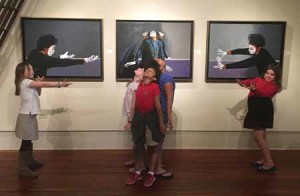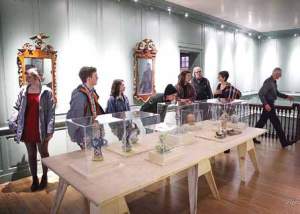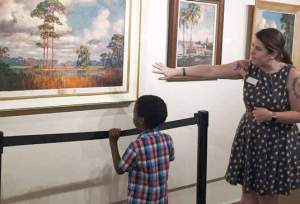
This article originally appeared in the November/December issue of Museum magazine, a benefit of membership with the Alliance.
Small museums might not think they have the resources to pursue accreditation, but these museums prove it͛s possible. By Dennis Pierce When Grace Robinson was director of education programs at Florida’s Vero Beach Museum of Art, she experienced the benefits of AAM accreditation firsthand.
Robinson saw how adopting high standards and following established best practices can prevent a museum from wasting precious resources and going around in circles, constantly dealing with the same problems. She also saw how accreditation offered a high-profile stamp of approval that lent credibility to the museum͛s entire operations.
“Quality breeds success,” she says. “As you grow and demonstrate that you͛re successful, resources naturally follow.”

So when Robinson became executive director of the Gadsden Arts Center & Museum near Tallahassee in 2005, she wanted her new institution to become accredited as well. However, at her previous institution, there had been five people in her department alone; her new museum had just two employees in all—including her.
But Robinson was not deterred. Under her leadership, the museum committed to meeting AAM’s Core Standards for Museums, the umbrella standards for all museums. The standards cover seven areas, including establishing public trust and accountability, delivering quality education and interpretation, the responsible stewardship of collections, financial stability, and risk management.
Gadsden Arts Center’s advisory board formed working committees around each of these topics and created a five-year strategic plan. The museum also partnered with Florida State University to provide students with hands-on museum training and the museum with additional capacity to complete necessary projects.
Over the course of a decade, Gadsden gradually put into place the requirements it would need to seek accreditation. In February 2016, Gadsden—which has an annual budget of less than $400,000 and a staff that now includes three full-time and four part-time employees—achieved accreditation for the first time.
“That was an enormous statement to our peers, to our donors, and to art collectors about who we are and how we do things,” Robinson says. It has opened many doors for us. Specifically, donations to the museum͛s art collection have increased in both number and quality, and visitor traffic is up.
Becoming accredited can be tough for small museums with limited resources. But Gadsden and others are proof that it can be done if museum staff are willing to commit to the process.
“Any museum that is interested can put itself on a path to accreditation by aiming to do everything according to best practices in the field,” Robinson says. “When you make that pledge of excellence, you reach a point where you are ready to apply for accreditation because the two go hand in hand.”
Planning and Intention
Preparing for accreditation requires careful planning and focus, and that͛s especially true for smaller institutions. Strong leadership is key.
When Brenda Abney was hired in December 2014 as director of the Tempe History Museum in Arizona, museum officials had already begun collecting the documentation needed for accreditation. Abney was tasked with moving the process forward to completion.
“With a small staff and budget, you need to prioritize tasks and align your budget to accomplish your objectives,” she says. While assessing its readiness to apply, the museum also began a fundraising campaign to cover the costs involved in accreditation.

The self-assessment turned up some small but important changes the museum had to make. For instance: We had people propping doors open all the time, and we realized that shouldn͛t happen, Abney says. We convinced our facilities manager that we needed a card-swipe system for better security. About two years after Abney was hired, the museum earned its accreditation.
When a museum has several steps to take to reach accreditation, knowing where to start can be difficult. For the Hemingway-Pfeiffer Museum in Arkansas, refreshing its advisory committee and crafting a well-defined strategic plan helped put the museum on a path toward accreditation, which it achieved last year. “Getting that structure in place was key,” says Director Adam Long.
Overcoming Obstacles
For small museums, in particular, time is one of the biggest barriers to accreditation. With a limited staff, everyone is already juggling multiple roles—and there are only so many hours in a day.
As with any big project, the key to success is taking it one step at a time. For example, Abney created a timeline with specific goals and milestones to keep the accreditation effort on track. She also dedicated time within staff members͛ work schedules for tasks related to accreditation.
“Having scheduled days to work on this project was invaluable,” Abney says. “Otherwise, the work would not have gotten done.”
Leveraging the support of volunteers is also critical. The Cable Natural History Museum in Wisconsin enlisted the help of former staff and other members of the community. “We had someone who had worked here for 20 years and then left to become a teacher,” says Deb Nelson, the museum͛s director. “She very generously helped us with our self-study.”
The Cable Natural History Museum was established in 1967 in a small lake town with fewer than 900 residents. With no air conditioning and no special storage area for its collections, the museum͛s original building was far from qualifying for accreditation. But after a snowstorm collapsed the roof, the museum constructed a new building, which opened in 2008. Officials viewed this as an opportunity to pursue accreditation.

A collection stewardship grant from the Institute of Museum and Library Services also helped ready the museum for accreditation. The museum hired a curator, added special film to its windows to preserve its collections, and paid more attention to disaster planning. Our 3,800 items are very well taken care of now, Nelson says.
Besides relying on volunteers and grant funding, the museum added money to its budget to hire more part-time staff to complete some accreditation process tasks—and it also took full advantage of AAM’s resources. “Don͛t be afraid to ask questions,” Nelson advises. “AAM was a wonderful resource for us, and they made us feel like no question was too silly to ask.”

Even with this support, challenges will inevitably crop up. When Wilton House Museum in Richmond, Virginia, applied for reaccreditation, the Accreditation Commission tabled its decision over concerns that the museum’s strategic planning process wasn͛t involving the people it serves. The Commission also wanted to see the museum’s plans to increase accessibility for visitors with disabilities.
The museum’s executive director, Keith MacKay, asked his board to reaffirm its commitment to accreditation. The board approved the hiring of an outside consultant, Floricane LLC, to help address the Accreditation Commission͛s concerns. Floricane identified a number of stakeholder groups—including educators, museum peers, and residents of Richmond—and invited representatives from these groups to a planning roundtable.
Pursuing accreditation is an important opportunity for museums to address how they function, MacKay says. In our case, it led to significant changes that have made us a stronger museum. It was a really rich and rewarding experience. After an 18-month process, Wilton House Museum was reaccredited in June 2017.
Significant Benefits
Accreditation can be challenging for small museums, but the benefits can be significant.
“For donors who ask, ‘If I give you this item, how will I know that you͛ll care for it?’ you can show them you͛re accredited, which proves that you meet high standards,” Abney says.
Accreditation has helped the Cable Natural History Museum recruit top-notch talent. “We’re a tiny community. Our closest Target store is 100 miles away. Yet we had 111 people from across the United States apply for our naturalist position,” Nelson says.
Museums also realize tremendous benefits simply from going through the process. “It gave us a reason to carve out time to do the things we should have been doing all along but weren’t, like dusting and rotating our collections,” Abney says. These good habits are now ingrained in the museum͛s operations.
Becoming accredited also improves staff morale, uniting everyone toward a common cause and instilling pride when the goal is met. Nelson notes that her institution is the only accredited museum in northwestern Wisconsin. “We celebrate that every day,” she says.
Meeting high standards has helped Wilton House Museum double its annual fund in the past five years, MacKay says. In addition, the museum has received loans from museums that would only lend to accredited institutions.
MacKay couldn͛t be more sold on the process: “These conversations need to be happening.”
4 Keys to Achieving Excellence
- Focus on quality over quantity. Plan carefully, and be selective about what you do. When the recession hit in 2008, Gadsden Arts Center & Museum pared back its initiatives and focused only on what it could afford to do well. A lot of museums try to be too much to too many people, and they end up not doing anything well, says Executive Director Grace Robinson. Whatever you are doing, aim to do it at the highest quality you can.
- Don’t go it alone. Make the time to network with peer institutions, and ask colleagues who have been through the accreditation process for their advice. Enlist the help of seasoned pros, Robinson advises, so you learn from their mistakes instead of your own.
- Help staff take ownership. Employees at small museums can be so busy with their day-to-day responsibilities that long-term goals get pushed aside. Set clear goals and milestones, and allocate time for completing them. During the accreditation process, Wilton House Museum staff members provided progress reports at each board meeting. Each staff member reported on their own activities to the board, says Executive Director Keith MacKay. That helped staff take ownership of the process.
- Don͛t sell yourself short. Despite having a small staff and limited budget, you can still achieve high standards, says Deb Nelson, director of the Cable Natural History Museum. Even if we hadn͛t received accreditation on our first attempt, the process made us better—and we would have kept trying.
More on These Museums
Cable Natural History Museum
$500,000 Institution Budget
5 Full-time staff
3 Part-time staff
Gadsden Arts Center & Museum
$390,000 Institution Budget
3 Full-time staff
4 Part-time staff
Hemingway-Pfeiffer Museum
$250,000 Institution Budget
3 Full-time staff
2 Part-time staff
Tempe History Museum
$619,000 Institution Budget
5 Full-time staff
2 Part-time staff
Wilton House Museum
$500,000 Institution Budget
2 Full-time staff
3 Part-time staff
Resources
AAM Accreditation & Excellence Programs
Tamara Hemmerlein, How Can My Small Museum Handle Core Documents Verification? a
Ann Fortescue, Excellence on a Small Scale
Dennis Pierce is a freelance writer based in Fitchburg, Massachusetts.







